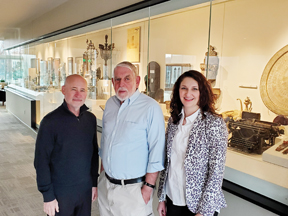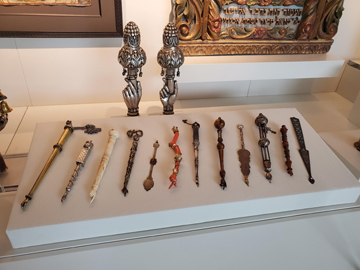
The Temple, Congregation B’nai Jehudah now owns one of the largest collections of Judaica in the country, thanks to Michael Klein. The collection is known as The Michael Klein Collection. Klein chose B’nai Jehudah as its new home because he wanted to keep the collection local and he wanted it to serve an educational purpose.
“The gift that Michael has given to B’nai Jehudah is literally one of a kind,” explained Senior Rabbi Arthur Nemitoff. “He did not just give the results of his life’s passion to the congregation. He gave the gift of Jewish meaning, connection and continuity to our children, to our adults and to the greater community. For with this collection and the attendant endowment with which to maintain and grow it, Michael gives the congregation the ability to touch souls and minds in emotional ways for generations to come. We are forever grateful for this unique treasure that he has bestowed upon us.”
The collection comprises close to 1,000 pieces, including items previously owned by B’nai Jehudah, Klein said. That count excludes items displayed on the walls throughout the building. Initially about 250 pieces of the collection will be featured in display cases in the building’s Kikar Helzberg (gathering center).
The collection features items from all over the globe, not just Eastern Europe.
“There are things from Afghanistan, India, China, Europe and the United States,” said Klein, who has been a member of B’nai Jehudah for more than 40 years. “A lot of them reflect the culture in which they come from, and the ways that Judaism has become part of people’s lives.”
Items in the collection range from biblical times to modern times, which shows a continuity over time, across geography and across cultures, Klein said.
“This collection contains world-class items and will be one of the great synagogue collections in the country,” he said. “I think B’nai Jehudah members will be proud to bring out-of-town visitors to The Temple to see it.”
Klein began collecting Judaica about 45 years ago, when his parents went to visit his sister and brother-in-law, who were temporarily living in Israel. His mother asked what he would like as a souvenir.
“I had visions of that turquoise bluish stuff that those of us of a certain age remember … so I just blurted out, ‘If you see an antique spice box, bring that back.’ They brought me back three.”
The collection began growing from there after Klein started visiting museums, reading books, meeting collectors, going to auctions and educating himself about Judaica. Over the years, he has tried to collect items related to every Jewish holiday; it wasn’t always easy.
For instance, finding items for Tisha b’Av was a challenge.
“The depth is not deep, but we have three things,” Klein said.
One of those things is a 500-year-old print from Germany of the destruction of Jerusalem. It is the second-oldest print of Jerusalem. The collection also includes two of the coins that the Romans issued to commemorate the destruction of Judea.
The collection also encompasses historic Temple items such as the LaFarge stained-glass windows from the Linwood Boulevard building and the original Torah, rimonim (crowns) and breastplate from the Oak Street building. The menorah from the Holmes Street building sanctuary is now prominently displayed in the renovated building on Nall Avenue after being in storage almost 20 years.
Klein said a set of murals had also been commissioned that would relate Temple history to biblical concepts.

Programming and education are key
As Rabbi Nemitoff mentioned, Klein has also provided an endowment to pay for additional acquisitions, programming and the salary for an educator/curator. Abby Magariel was hired by the congregation earlier this year to fill that role.
Klein definitely didn’t want the objects in his collection to be “pretty in a case or paintings to hang on a wall,” although some will rotate in display cases.
“To me, programming is the key,” said Klein, who is a member of the acquisitions committee of the Jewish Museum in New York. “If it was just going to be pretty things in a case or pictures on a wall, I wouldn’t have donated the stuff. There’s no point. You can go anyplace for that.”
As part of his goal of keeping the collection local, Klein wanted the entire community to benefit from its educational aspect, he said.
“There’s already a lot of community interest in the collection,” said Magariel, noting that the Jewish Studies department at the University of Kansas is building a course around the collection.
“The whole key is having a brilliant staff member who is experienced in using objects in programming to educate, and I think we have that in Abby,” Klein said.
Magariel earned a master’s degree in museum studies at the University of Kansas. She has worked at the Kansas Historical Society in Topeka and was the education director at the Douglas County Historical Society in Lawrence at the Watkins Museum.
“To this point in my career, I have been a teacher and an educator with the understanding of how to manage a collection and how to care for it,” she explained. “This has been really exciting in that I get to do both.”
Magariel said she was happy she’d be able to “help kids and families use these beautiful objects to inform their own growth as Jews. I like that for the congregants.”
Now that B’nai Jehudah has moved back into its building, staff have started to create a calendar of programs, Magariel said.
“Some of the first things that we are emphasizing are getting children and families involved with the collection,” she said. “That means putting together special programs for that audience.”
For example, Magariel has begun planning a program centered around Havdalah rituals featuring art and music taught by Laura Payne. These sessions will teach about the ritual objects used at Havdalah — candlesticks, Kiddush cups and spice boxes — and the ritual itself.
“We’ll look at examples of these objects that are in the collection, (and) then kids will be able to make one of those three things so that if they attend all three sessions, they will end up with a complete Havdalah set,” Magariel said.
Klein said it’s important to note that, as with the Havdalah program, Magariel will bring in local teachers and others with expertise to lead various programs.
“We have so many people with great skills and talents in our community,” Magariel said.
The Michael Klein Collection’s educational programs will be separate from the congregation’s Religious School. However, the school’s educators, under the direction of the congregation’s Director of Formal and Informal Jewish Education Dayna Gershon, will incorporate the collection into the curriculum.
“I will be augmenting teachers’ lessons by bringing in examples of art and ritual objects to their classes,” Magariel said.
Programs for adults are also in the works. One involves training docents about the collection so they can speak about it to visiting Jewish and non-Jewish groups.
Some of the items in his collection, Klein said, will help people, especially children, take an abstract concept of a holiday and “help make it concrete.”
“All of this is being done to educate people, to pull them in, to start increasing their Jewish literacy and to start to understand the wonderful heritage that we’ve all been given that’s developed over thousands of years,” Klein said.
Programming is the key to this entire enterprise, Klein and Magariel emphasized.
“If it were at any other synagogue, this collection would be pretty things in cases,” Magariel said. “Or if this type of collection goes to a large museum, it largely stays in storage because art museums at best display 10% of their collections at any given time, and it’s usually between 3% and 5%.”
One of the reasons Klein is so excited about the educational aspect of the collection is because at age 73, he is still learning new things.
“After all these years, I discover new things all the time,” he said. “Hardly a day goes by that, when I see things come up at auction or I see things in a museum when I’m traveling, that I don’t learn from them. I think lifelong learning is something that is very Jewish.
“If we can get people interested in art, and wondering, ‘What’s this about?’ and learning a little bit more, then I think this collection will have accomplished its purpose,” Klein added.


